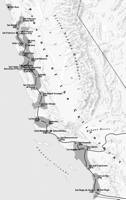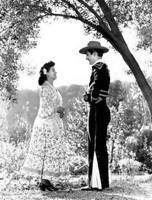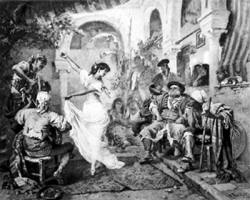
|
The Society of Folk Dance Historians (SFDH)
Life and Dance in Early California
[
Home |
About |
Encyclopedia | CLICK AN IMAGE TO ENLARGE |

|
BACKGROUND
". . . there were never a more peaceful or happy people on the face of the Earth than the Spanish, Mexican, and Indian population of Alta California before the American conquest. We were the pioneers of the Pacific Coast, building towns and missions while George Washington was carrying on the War of Independence."
 So wrote Guadalupe Vallejo, son of General Mariano Vallejo, in 1890, recalling the years of his youth whan the "Californios" occupied the land from San Diego's Silver Strand to his father's home in Sonoma, north of San Francisco Bay.
So wrote Guadalupe Vallejo, son of General Mariano Vallejo, in 1890, recalling the years of his youth whan the "Californios" occupied the land from San Diego's Silver Strand to his father's home in Sonoma, north of San Francisco Bay.
Great ranchos of thousands of acres, stocked with thousands of head of cattle, were the economic and social base of the Early California's people. Land grants were awarded by the Mexican government to almost anyone who offered to settle in this remote region, transforming more than one landless soldier into instant dons. Living isolated haciendas separated by several days' travel with a tradition of refined elegance and separated from the Mexican government by several weeks' travel, the Californios naturally developed their own life style adapted to their unique environment. California consisted of vast stretches of fine land, well drained, with a temperate climate and plentiful game. A readily-available coastline with numerous fine harbors allowed the development of commerce with seafaring countries – such as the United States.
Men lived life in the saddle, tending the vast herds and deigning to walk, it would seem, across the road. They were responsible for ensuring economic survival and providing food for the enormous numbers of family and hands on the rancho. They developed one of the most sophisticated and expert traditions of horsemanship and horse breeding in the world, a trademark of their Spanish heritage. Travelers from the far corners of the world often recorded astonishment at the feats of these horsemen.
 A woman's life was a toilsome task, the doña responsible for supervising all the household staff of Indian servants and teaching her enormous brood the skills required to survive in the wilderness that was Alta California. It required large numbers of people to make a rancho work and all had to be fed, clothed, taught, and trained.
A woman's life was a toilsome task, the doña responsible for supervising all the household staff of Indian servants and teaching her enormous brood the skills required to survive in the wilderness that was Alta California. It required large numbers of people to make a rancho work and all had to be fed, clothed, taught, and trained.
Travelers also commented on the extreme grace and politeness encountered everywhere, even among the poorest of the people. That tradition of courtesy and grace was at the core of Californio life and drove the development of social traditions.
Women dressed in the finest silks and velvets they could get from the trading ships that called to trade for the hides and tallow produced by the ranchos and missions. Such visits were eagerly awaited by the women and they would gaily board every ship to pore over the trade goods brought from far away China – silks, satins and velvets, gold jewelry, satin slippers, ivory combs and fine lace, embroidered shawls, and glass beads. In her full, ruffled skirt, elegant hairdo with the popular Spanish comb, shoulders wrapped with an elegant embroidered silk shawl with long fringe, she was an image of feminine beauty, Californio style.
The Californio male was an impressive sight when dressed in full regalia. He was crowned by a wide hat with a round or flat crown. Knee-length velvet trousers in dark colors were worn over a pair of ankle-length white linen trousers, wide at the ankle. After about 1840, the knee-length trousers were extended to the ankle, open and buttoned on the outside seam from waist to ankle. They were worn unbuttoned from the knee down to display embroidered and tooled leather "botas" bound around the knee with long silk, tasseled cords and reaching to the instep of the boot and the large-rowelled spurs. A waist-length embroidered jacket matching or contrasting with the trousers, and a fringed silk sash knotted on the right side, completed the ensemble. Every man owned, and often wore, a fine Toledo sword and carried a braided quirt.
When mounted on a fine horse with silver-mounted, tooled and embroidered saddle, the Californio was indeed an imposing, colorful figure. Sadly, his day was to last only a couple of decades, from the mid-1820s to the mid-1840s when the Mexican War upset the old order and Americans began to flow into California in ever-increasing numbers. The subsequent losses to American forces under General Kearney, the discovery of gold, and annexation by the United States delt a final blow to this fine experiment in genteel living.
It is a warm afternoon in October and a fiesta is underway at the hacienda of a great rancho in Alta California. The year is 1842. Nearly a hundred señoras and señoritas, caballeros, dons and doñas are gathered under the trees along the Los Angeles River to welcome the captain, crew, and passengers of an American trading ship anchored just offshore. They have celebrated with feasting and games for two days.
Tonight will be special, because there will be a fandango that will last through the night. Don Juan Bandini will be there. He traveled all the way from San Diego! No fandango can be complete without the famous tecolate to call the dance. The young people have already made promises of a dance and anticipation runs high.
At the moment, everyone's attention is drawn to a demonstration of horsemanship by the vaqueros, some of the finest horsemen in the world. A popular game has been prepared. A fine rooster has been bound and buried up to its neck in soft sand. Twenty yards away, a half dozen mounted vaqueros wait. At a signal, the first man springs his horse to a full gallop toward the hapless bird, swings down from the saddle, grasps fot the bird's head – and misses! Loud cheers from the onlookers for a fine effort greet the man's embarrassed grin.
The next man touches spurs, bears down on his prize and deftly plucks the squawking rooster from the sand. Louder cheers and whistles abound as the revelers move closer.
Another rooster is brought forth. And another as the remaining vaqueros take their turns – four misses and two catches.
A challenger! Adon has wagered the owner of the rancho, famous for his horsemanship, that he cannot pick a coin from the ground from his galloping horse. Such as wager cannot be ignored! A man's honor must be upheld!
The challenger places a gold coin on a bare spot of ground. The challenged man rides his fine palomino to the starting place, pauses for dramatic effect. No one breathes. The Americans already astounded by the display, place their own bets.
At a signal unseen by the onlookers, the palomino springs forward, its rider intent on the tiny coin he is rapidly approaching. At the last possible instant, the rider leans from the saddle, stretches to the ground, and the coin is his! He holds it high for the cheering crowd to see. His reputation is saved!
On that high point, preparations begin to return to the hacienda. Young caballeros assist the ladies into the ox carts, then spring to their saddles and either race to the house or ride alongside to tarry a bit longer with the ladies.
At the hacienda, all is in readiness. The Indian musicians are tuning their instruments: two violins, a guitar and a harp, and even an accordion-like instrument brought as a gift by the American captain. One of the musicians is quickly and happily learning to play it.
Food and drink cover a table alongside the patio. Servants scurry about under the watchful eye of the doña at word of the approaching guests. The first horsemen arrive, breathless from their two-mile run, the don among them. He springs from his horse, tosses the reins to a servant and removes his huge rowelled spurs.
 Without missing a beat, the fandango is about to begin.
Without missing a beat, the fandango is about to begin.
The ladies arrive and quickly enter the house to freshen up and dress properly for the fandango. Only two days earlier they had acquired new dresses from the American ship in trade for the rancho's hides and tallow. Colorful multi-tiered skirts are pulled over petticoats, combs of ivory and tortoise shell are placed just so and draped with elegant lace mantillas. Sturdy walking shoes are exchanged for elegant dance slippers and soon all are gathered on the patio, ready to begin.
When the ladies are seated around the patio, Don Bandini steps forward and all conversation ceases. With a few words of welcome, Sr. Bandini nods to the musicians. A gentle tune begins and the tecolate approchas the doña, seated at a place of honor, and begins to gently clap his hands to the rhythm. The doña nods, stands, and walks proudly to the center. Her Andalucian ancestry is evident in her proud carriage as she begins to stamp a rhythm to the guitar, countering Bandini's brief flurry of zapadios, then abruptly ceases and returns demurely to her seat. The fandango has begun.
Bandini repeats the invitation to the next lady, and the next, each repeating the doña's display with varying degrees of skill, until all have been introduced.
The pace quickens as Bandini calls for the first jota, this one from western Spain. Two young couples step forward to dance their family heritage, handed down to them through several generations reaching back to the conquistadores. It is an earthy dance, gently flirtatious, requiring no little skill. Other couples join the dance in turn and retire amid enthusiastic applause.
The popular varsouvienne is next. Bandini adroitly pairs young dancers together and young and old join in this gentle mazurka.
"Sevillanas!! The cry from an eager daughter of Andalucia and the music obliges. Two women begin, thrilling all with the bold elegance of their dance of southern Spain. Palmas quicken as a young man joins the pair, dancing now alone, now with one or the other of the women with masculine restraint and grace.
It is time for the vals jota, created by the Californios themselves. Parallel lines form quickly, couples facing couples. Bandini's nod sets the dance moving and skirts swirl as caballeros lead their partners through the figures with a curious two-step in waltz time.
Don Bandini is considered the finest dancer in California and he is called upon to prove it now. He gracefully nods and moves to the center of the floor. He is wearing the traditional white trousers and light slippers of Aragon, his family's origin in eastern Spain. With the first note of the Jota Aragonessa, he is off, springing into the air in a series of flawless leaps and spins, seeming to come to earth only to leave it again, telling in dance the story of the mountainous land of his ancestors. As quickly as it began, the dance ends with the tecolate on bended knee to the shouts and applause of an appreciative audience. He has done it again!
DOCUMENTS
- Early California Fandango, an article.
- Richard Duree, an article.
Used with permission of the author.
Printed in Dance Traditions, April and May 1999.
This page © 2018 by Ron Houston.
Please do not copy any part of this page without including this copyright notice.
Please do not copy small portions out of context.
Please do not copy large portions without permission from Ron Houston.